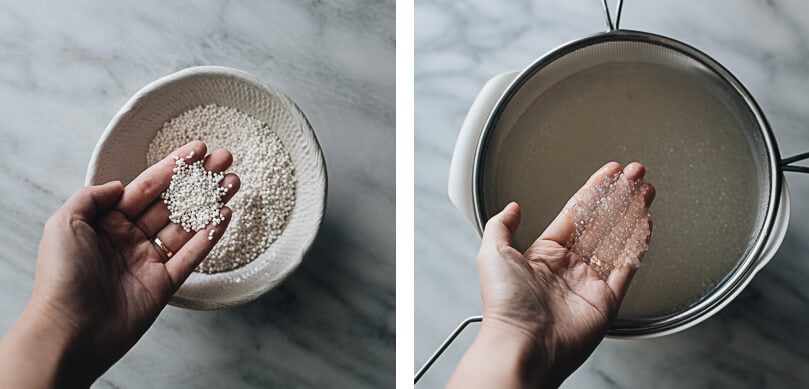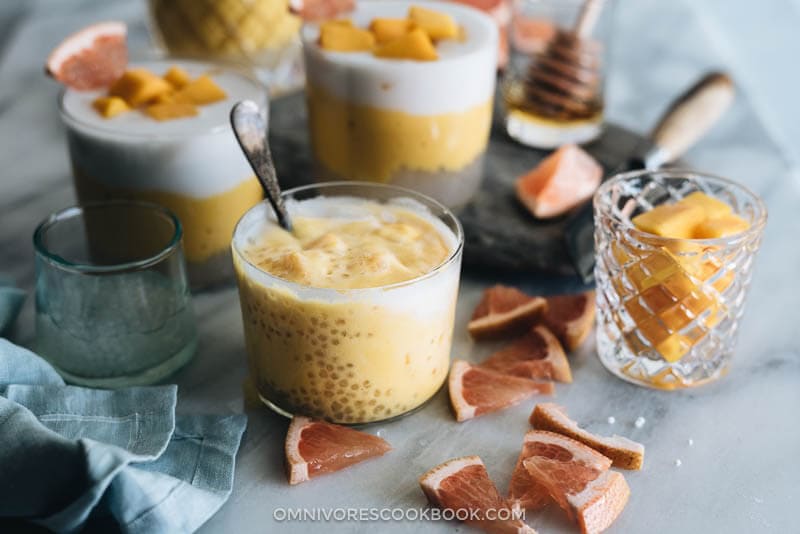Mango sago is a popular dessert in Hong Kong and Taiwan. The first time I had this dessert was when the famous Hongkongese dessert shop Honeymoon Dessert (满记甜品) opened in Beijing. I was hooked! The sweet creamy fruity base was loaded with gooey tapioca pearls and mango chunks. It was a magical moment when I felt extremely happy after eating a spoonful of the mango sago. It immediately became my favorite summer dessert. It never even crossed my mind to make this dish at home until I moved to the US. Now it’s a 20-minute drive to the closest Asian dessert store where I can get my sweet tooth satisfied. After a while I decided it was time to learn how to make the dish myself.
Cooking notes
1. Ingredients
Making the restaurant-style version of this dish is surprisingly easy. All you need is: Ripe mangoes, evaporated milk, coconut milk, and small tapioca pearls. A lot of dessert shops also use pomelo pulp in this dessert. If you cannot find pomelo, you can use grapefruit instead. You can also skip the citrus altogether.
2. How to prepare sago
The best way is to follow the instructions on the package you have, since cooking methods and times vary. Some brands recommend boiling all the way through, while others ask you to soak the tapioca pearls after boiling. If your package does not come with instructions, simply boil them until most of the pearls turn transparent. It is OK that some of them have a small white dot in the middle. They will continue cooking a bit more when you drain them, and eventually turn completely transparent.
3. What type of milk to use
After trying a few recipes, I found that the combination of evaporated milk and coconut milk works best. This recipe blends evaporated with the mango, to create a very creamy and fruity layer that is neither too runny nor too heavy. Some recipes call for condensed milk in this step, which makes the mixture too sweet. Heavy cream makes the mixture quite dense. On the other hand, milk will make the paste runny. If you want to make the dish vegan, you can use a blend of coconut milk and plant-based milk (see the headnote in the recipe below) to create a similar texture. The recipe finishes the dish with a top layer of coconut milk, which makes for a beautiful presentation.
4. Adjust the sweetness
I rarely need to add any sugar to my mango sago if the mangoes are very ripe. The finished product is not too sweet, which allows you to taste the original flavor of all the ingredients. However, if you prefer a sweeter dessert, you can either add sugar into your mango paste or serve the dessert with some syrup on the side, so your guests can sweeten it as they like. Both agave syrup and coconut syrup work well.
That’s it! The last time I made a big batch of this, my husband ate three cups in one sitting because it was too irresistible! Well, since the dessert is made with all-natural ingredients and is quite low in calories, we felt no guilt even after eating too much! Now we call this homemade version of mango sago “happiness in a cup” 🙂
If you give this recipe a try, let us know! Leave a comment, rate it (once you’ve tried it), and take a picture and tag it @omnivorescookbook on Instagram! I’d love to see what you come up with.







